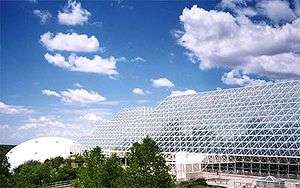Closed ecological system
Closed ecological systems (CES) are ecosystems that do not rely on matter exchange with any part outside the system.
The term is most often used to describe small manmade ecosystems. Such systems are scientifically interesting and can potentially serve as a life support system during space flights, in space stations or space habitats.[1]
In a closed ecological system, any waste products produced by one species must be used by at least one other species. If the purpose is to maintain a life form, such as a mouse or a human, waste products such as carbon dioxide, feces and urine must eventually be converted into oxygen, food, and water.
A closed ecological system must contain at least one autotrophic organism. While both chemotrophic and phototrophic organisms are plausible, almost all closed ecological systems to date are based on a phototroph such as green algae.
Examples
A closed ecological system for an entire planet is called an ecosphere.[2][3]
Man-made closed ecological systems which were created to sustain human life include Biosphere 2, MELiSSA, and the BIOS-1, BIOS-2, and BIOS-3 projects.[4]
Bottle gardens and aquarium ecospheres are partially or fully enclosed glass containers that are self-sustaining closed ecosystems that can be made or purchased. They can include tiny shrimp, algae, gravel, decorative shells, and gorgonia.[5]
In fiction
The 1993 novel This Other Eden by Ben Elton featured the development of "claustrospheres" which were closed ecological systems contained within a dome in which people could take refuge in the event of environmental collapse.
The critically panned 1996 comedy film Bio-Dome involved the protagonists becoming trapped in a closed ecological system being run as an experiment.
See also
- Biosphere – The global sum of all ecosystems on Earth
- Controlled ecological life-support system
- Controlled-environment agriculture
- IBTS Greenhouse
- Ecology – Scientific study of the relationships between living organisms and their environment
- Ecosphere – A planetary closed ecological system
- Ecosystem services
- Eden Project – Visitor attraction in Cornwall in the United Kingdom
- Micro landschaft – Miniature artificial landscape
- Space colonization – Concept of permanent human habitation outside of Earth
- Spome – Hypothetical matter-closed, energy-open life support system
- Terraforming – Hypothetical planetary engineering process
- Chang'e 4 – Chinese lunar lander
References
- I. I. Gitelson; G. M. Lisovsky & R. D. MacElroy (2003). Manmade Closed Ecological Systems. Taylor & Francis. ISBN 0-415-29998-5.
- "A Lexicon of the Spheres" (PDF). Oregon State University. Archived from the original (PDF) on 2016-10-18. Retrieved 2016-10-16.
- "ESO 2 Science 11: The Ecosphere and the Ecosystems". Science Helpdesk.
- Salisbury FB; Gitelson JI; Lisovsky GM (Oct 1997). "Bios-3: Siberian experiments in bioregenerative life support". BioScience. 47 (9): 575–85. doi:10.2307/1313164. JSTOR 1313164. PMID 11540303.
- "What is an EcoSphere? (Shrimp and Gorgonia coral)".
